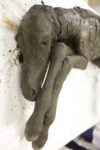 The remains of an eerily intact foal has been discovered in the melting permafrost of Siberia. Preserved in the ice for tens of thousands of years, the baby horse was found by paleontologists from Yakutian North-Eastern Federal University in the Batagaika crater in Yakutia, Russia. Scientists identified the foal as a Lena Horse, a species that inhabited the area 30,000-40,000 years ago and has no genetic link to the freaking adorable wild horses that roam Yakutia today.
The remains of an eerily intact foal has been discovered in the melting permafrost of Siberia. Preserved in the ice for tens of thousands of years, the baby horse was found by paleontologists from Yakutian North-Eastern Federal University in the Batagaika crater in Yakutia, Russia. Scientists identified the foal as a Lena Horse, a species that inhabited the area 30,000-40,000 years ago and has no genetic link to the freaking adorable wild horses that roam Yakutia today.
 The little fella was two months old when he died. There is no physical evidence on his body of what caused his premature death. As a matter of fact, there are no blemishes of any kind, no decay, no damage from scavengers, no tissue loss, not even hair loss. Its ears, tail, nostrils and nostril hairs are untouched by the passage of 40,000 years.
The little fella was two months old when he died. There is no physical evidence on his body of what caused his premature death. As a matter of fact, there are no blemishes of any kind, no decay, no damage from scavengers, no tissue loss, not even hair loss. Its ears, tail, nostrils and nostril hairs are untouched by the passage of 40,000 years.
 Researchers at the North-Eastern Federal University were able to collect a wealth of samples from this perfectly intact horse. They took hair, tissue and fluid samples from the foal and detailed measurements. The foal is 39 inches high at the withers. The research team also took samples of the soil covering the find site.
Researchers at the North-Eastern Federal University were able to collect a wealth of samples from this perfectly intact horse. They took hair, tissue and fluid samples from the foal and detailed measurements. The foal is 39 inches high at the withers. The research team also took samples of the soil covering the find site.
“We’ll study content of its bowel to understand the foal’s diet. The autopsy will be carried later”, said [head of Yakutia Mammoth museum Semyon] Grigoryev.
Deputy Head of the North-Eastern Federal University Grigory Savvinov said the foal must have fallen into a natural trap.
 In this trap scenario, the foal would have fallen into water and drowned. The water would then have quickly frozen over, preserving the benighted creature in perfect condition.
In this trap scenario, the foal would have fallen into water and drowned. The water would then have quickly frozen over, preserving the benighted creature in perfect condition.
Here’s a short video of the research team examining the foal. The closeup of a cut in the skin where a sample of tissue was removed at the 1:29 mark is something else.